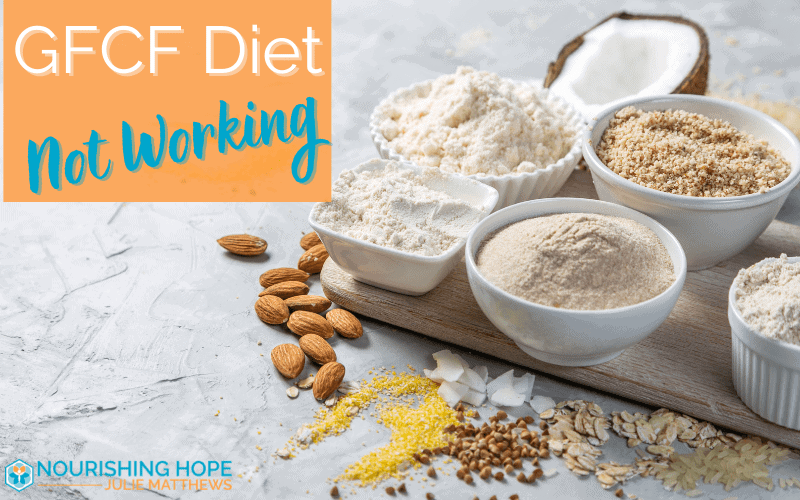
10 Strategies for the GFCF Diet Plan for Autism and ADHD
Starting on a gluten-free and casein-free (GFCF) diet for your child with ADHD, autism, anxiety, or other neurological/special needs can result in profound improvements. Let’s start by defining what these things are. Gluten refers to the proteins found in wheat, rye, barley, spelt, kamut, and triticale. Gluten helps foods maintain their shape, acting as a glue that holds food together. It can be found in many types of foods, dressings, sauces, and condiments. Casein is a protein found in milk and other dairy products. Similarly to gluten, casein protein can be found in many things, not just dairy products. In this article whether we say gluten-free and casein-free or gluten-free and dairy-free, we are generally talking about the same thing.
Implementing a gluten-free and dairy-free diet can potentially offer a wide range of benefits for your child. Improvements can be varied and include receptive and expressive language, enhanced cognition, better sleep cycles, less hyperactivity, improvements in constipation, and a decrease in disruptive behaviors. Consistently following a special therapeutic diet can offer immense benefits for your child.
In fact, one study found that over a 5 month period, participants on a gluten-free diet showed an improvement on a number of behavioural measures.[1] If you are interested in the science behind a GFCF diet, read my article on 7 science-based reasons a GFCF diet affects the brain and autism.
But, not every child responds the same way to dietary intervention and sometimes parents may wonder why a dairy-free and gluten-free diet is not working for their child.
Maybe you thought behavior would improve, or perhaps you were hoping for improvements in digestive symptoms, sleep, rashes, anxiety, hyperactivity, irritability, or language.
Maybe the diet was working at first, or maybe you never saw the results you were hoping for.
I have heard these challenges in my practice over the last 20 years and I tell parents that there can be a number of things for them to consider. I will share my top 10 reasons why a GFCF diet may not be working and offer strategies that can help.
So if you’re asking the question:
Why is the GFCF diet not working? Or Why is the GFCF diet not working anymore?
… you’re in the right place.
Here are 10 strategies to help when the GFCF diet is not working:
1) Infractions
 Firstly, let’s define what an infraction is. It simply means that some small – even minute – amount of gluten protein and/or casein protein is still getting into your child’s diet or can even be absorbed through their skin. This can be from many different sources including:
Firstly, let’s define what an infraction is. It simply means that some small – even minute – amount of gluten protein and/or casein protein is still getting into your child’s diet or can even be absorbed through their skin. This can be from many different sources including:
Treats or foods at Grandma or Grandpa’s house
Treats or foods at school or daycare
Cross-contamination is when a gluten-free and/or casein-free food is sliced, prepared, heated, fried, or placed with foods that contain gluten or casein
Personal care products like lotions or shampoos
Craft items like Play-Doh
If your child’s diet is not 100% gluten-free and dairy-free compliant, that can interfere with seeing positive results.
Success Strategy – Keep going. Review your child’s diet and personal care products or things like Play-Doh for gluten and dairy. There can be many names for both of these compounds so make sure you are checking everything. Also, it is important to communicate with well-meaning friends, relatives, and school/therapy personnel. To see the potential gains, you have to be strict so yes, even 1 bite can hurt the progress you are making. And since it takes a while for gluten and dairy to leave your child’s system, being consistent with avoidance – including cross-contamination – is key to success.
2) Salicylates Interfering With Symptom Improvement
 Salicylates are naturally-occurring food chemicals in fruits, vegetables, and other plant foods like herbs, spices, nuts, etc., and in artificial additives and food colorings. So even gluten-free and dairy-free foods can be high in salicylate and if your child is sensitive to these compounds, it could be masking the positive benefits from a gluten-free and dairy-free diet.
Salicylates are naturally-occurring food chemicals in fruits, vegetables, and other plant foods like herbs, spices, nuts, etc., and in artificial additives and food colorings. So even gluten-free and dairy-free foods can be high in salicylate and if your child is sensitive to these compounds, it could be masking the positive benefits from a gluten-free and dairy-free diet.
High salicylate foods can cause red cheeks or ears (not related to heat), hyperactivity, irritability, bed wetting, aggression, sleep challenges, and other symptoms in some children.
One of the most common experiences I see with clients is that they do a GFCF diet and hope to see improvements in hyperactivity, behavior, and physical symptoms, but they don’t. So they figure “diet,” or a GFCF diet specifically, must not work for them. But instead of giving up, I encourage them to try also removing salicylates. Then, all of the reduction in symptoms and the gains they hoped to see suddenly happen!
It’s important not to give up on diet but to dig deeper!
Some foods that are high in salicylates include:
- Strawberries
- Blueberries
- Raspberries
- Red grapes
- Most melons including watermelon
- Peaches
- Nectarines
- Plums
- Apples
- Red bell pepper
- Cucumbers and pickles
- Ketchup
- Tomato sauce
- Zucchini (with peel on)
- Cinnamon and spices
- Almonds
- Honey
Success Strategy – If you’ve implemented a gluten-free and dairy-free diet and are seeing things like the symptoms listed above or irritability, defiant behavior, aggression toward self or others and your child is eating many of the high salicylate foods listed above, it may be worth reducing or eliminating those foods as well and assessing how your child feels and behaves as a result. But, it doesn’t mean that the gluten-free and dairy-free diet is not working, it just may mean that there are additional compounds that are also presenting a challenge for your child’s body to process.
3) Additional Food Sensitivities Causing Inflammation
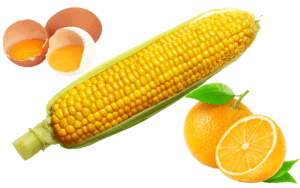 When a food causes inflammation in the body there can be many reactions both physically and behaviorally. Removing gluten and dairy is a great start in reducing inflammation because both of these are inflammatory foods. But, each person is unique and any food can be or become inflammatory, even those we consider “healthy.”
When a food causes inflammation in the body there can be many reactions both physically and behaviorally. Removing gluten and dairy is a great start in reducing inflammation because both of these are inflammatory foods. But, each person is unique and any food can be or become inflammatory, even those we consider “healthy.”
The most common food sensitivities (in addition to wheat and dairy) are:
- Soy
- Corn
- Eggs
- Citrus
- Peanuts
- Nuts
- Chocolate
- Sugar
So once again, if you have removed all exposure to gluten and dairy and still are not seeing the results that you want, exploring food sensitivities is a good next step.
Success Strategy – Again, stick with a gluten-free and dairy-free diet, but also eliminate specific foods that your child is reacting or sensitive to. And not all food sensitivities are visible like a rash. Sometimes they cause underlying inflammation in the system that you can’t see on the outside, but that affect the brain and get in the way of you seeing improvements.
4) Food Additives
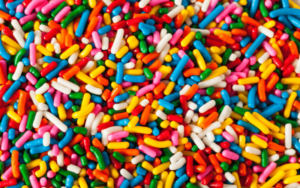 Chemicals and additives in foods can trigger behavioral issues that can mask the benefits seen from a gluten-free and dairy-free diet. As mentioned above, sometimes the issue is related to salicylates – as in the case of artificial colors – or it can be because of another food compound. Artificial colors, artificial flavors, and preservatives are three very problematic food additives for behavior. Studies show artificial colors and preservatives cause hyperactivity in children.[2]
Chemicals and additives in foods can trigger behavioral issues that can mask the benefits seen from a gluten-free and dairy-free diet. As mentioned above, sometimes the issue is related to salicylates – as in the case of artificial colors – or it can be because of another food compound. Artificial colors, artificial flavors, and preservatives are three very problematic food additives for behavior. Studies show artificial colors and preservatives cause hyperactivity in children.[2]
Another problematic food additive is MSG and related substances high in glutamate. Glutamate is an excitatory neurotransmitter that causes a feeling of excitability and hyperactivity, as well as anxiety, aggression, and other stimulatory sensations – and can be found in food. It is not only found in MSG-type additives such as monosodium glutamate and autolyzed yeast extract, but also in foods naturally high in free glutamate, such as soy sauce, parmesan cheese, and marmite. Glutamate is often found in similar foods as amine foods such as sauerkrauts and bone broths.
These food additives can cause a lot of behavior issues that can mask any beneficial results you were hoping for with the GFCF diet.
Success Strategy – Cooking a healthy gluten-free and dairy-free diet with as many home-cooked foods as possible is the easiest way to overcome this possible challenge. Reading food labels and knowing exactly what is in the foods your child is eating is essential. And eliminating food colors, preservatives, and chemicals is a tremendous step towards the positive improvements you are hoping to see.
5) Chemicals Around The Home
 We don’t often think of chemicals in our home interfering with a GFCF diet, because we are not eating these chemicals. However, when we are exposed to them through breathing them in or putting them on our body, they can have detrimental effects.
We don’t often think of chemicals in our home interfering with a GFCF diet, because we are not eating these chemicals. However, when we are exposed to them through breathing them in or putting them on our body, they can have detrimental effects.
Synthetic fragrances found in air “fresheners,” candles, fabric softeners, and body care products can also contain salicylates as well as dozens of chemicals that can negatively affect mood, behavior, and brain function. There are many chemicals to be careful of including cleaning products, detergents, antibacterial soaps, flea treatments, and more.
With some of these chemicals you might see immediate reactions that interfere with diet results; whereas, with others there can be long term damage that you might not notice right away.
Success Strategy – Avoid chemicals and choose natural options. Pay attention to any chemicals you use in your home and seek out more natural products. Additionally, only put natural body care products on your skin or your child’s skin. And be careful of anything you breathe in that could negatively affect your family.
6) Grains Are Irritating The Gut
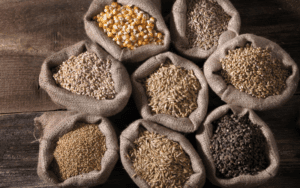 Again, the issue of inflammation can be a big one and can mask many of the benefits of a gluten-free and dairy-free diet. Grains and starches can be difficult to digest, especially for some people, such as those with gastrointestinal disorders and microbiome imbalance and can cause irritation – and even inflammation – of the gut, impacting GI symptoms and the microbiome. The gut and brain are closely tied so when the gut is irritated, the brain is often negatively impacted.
Again, the issue of inflammation can be a big one and can mask many of the benefits of a gluten-free and dairy-free diet. Grains and starches can be difficult to digest, especially for some people, such as those with gastrointestinal disorders and microbiome imbalance and can cause irritation – and even inflammation – of the gut, impacting GI symptoms and the microbiome. The gut and brain are closely tied so when the gut is irritated, the brain is often negatively impacted.
If your child is still experiencing digestive symptoms after doing a diet that removes gluten, casein, soy, and any personal sensitivities, a grain-free diet trial may be beneficial. Working with an integrative physician knowledgeable about underlying issues is important. Through them you can do specialized testing that can give you much information on whether grains may be presenting a challenge for your child. Leaky gut, candida overgrowth, bacterial overgrowth, and other gut imbalances can indicate a benefit to following a grain-free diet.
Success Strategy – The strategy here would be to transition from a gluten-free and dairy-free diet to also exclude grains. Most grain-free diets such as the Specific Carbohydrate Diet, GAPS diet, or Paleo also remove starches like potatoes which can be helpful. Many gluten-free products use rice flour, millet, quinoa, or potato as common ingredients. If your child suffers from gut issues, those grains and starches break down into sugars which can feed those imbalances in the gut. So, by removing grains and starches, you remove the food source for the pathogenic bacteria and fungus, and improve both the gut and the brain.
7) Microbiome Imbalance / Infections
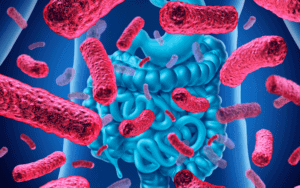 As we discussed briefly in the section on grains, when your child is experiencing gut issues like leaky gut, dysbiosis (imbalanced bacteria), and gut pathogens, because of the gut-brain connection, it can have a profound impact on your child and their ability to function. While a gluten-free and dairy-free diet is likely helpful, it can be hard to see the effects while the body is also dealing with this other issue.
As we discussed briefly in the section on grains, when your child is experiencing gut issues like leaky gut, dysbiosis (imbalanced bacteria), and gut pathogens, because of the gut-brain connection, it can have a profound impact on your child and their ability to function. While a gluten-free and dairy-free diet is likely helpful, it can be hard to see the effects while the body is also dealing with this other issue.
As we mentioned in diet strategy #6, grain-free and starch-free diets can be helpful with dysbiosis.
Another strategy is a low FODMAPs diet. FODMAPs are fermentable carbohydrates that bacteria feed on and can create gas, bloating, pain, diarrhea, and constipation.
Additionally, a low oxalate diet can be helpful with dysbiosis, as high oxalates damage the microbiome. We’ll talk more about this diet strategy in #10.
Sometimes, more than one diet is implemented and in other times people switch to a new diet. But in a vast majority of situations, gluten-free and casein-free are still recommended.
Success Strategy – The strategy here would be to discuss any medical issues with your physician. From a dietary perspective, you can support the good, healthy gut bacteria by eating a clean, whole foods diet and adding in probiotic rich foods. Sauerkraut, kimchi, homemade dairy-free yogurt, kombucha are just a few things that can be rich in probiotics and can be beneficial to add to the diet,while you consider which therapeutic diet or principles might help.
8) Sugar
 Sugar can be inflammatory, cause behavioral reactions, and even deplete vital minerals. Sugar can create problems in the body which could be interfering with the success of your gluten-free and dairy-free diet.
Sugar can be inflammatory, cause behavioral reactions, and even deplete vital minerals. Sugar can create problems in the body which could be interfering with the success of your gluten-free and dairy-free diet.
Since sugar is inflammatory, it can cause digestive and systemic inflammation that can lead to a worsening of symptoms. Sugar can also negatively impact behavior and ADHD, so a high sugar diet can mask improvements or “counteract” benefits of a GFCF diet.
Furthermore, sugar is another compound that can make gut dysbiosis worse. Since the pathogenic organisms feed off of sugar, a diet high in sugar is going to contribute to the growth of those bugs. This can cause behavioral and learning issues which can interfere with the benefits seen from a gluten-free and dairy-free diet.
In fact, I wrote a blog on avoiding sugar.
When undertaking a nutritional intervention for your child with autism, it is important to stick to whole, unprocessed, fresh, and organic foods whenever possible.
Success Strategy – The obvious thing is to reduce or eliminate sugar. This can be done in a few ways. There are other sweeteners which can be enjoyed like coconut sugar that can make the switch easier. You can simply switch out regular white sugar for coconut sugar and slowly begin reducing from there. Coconut sugar has a lower glycemic index, but keep in mind it is still sugar and has negative properties like feeding yeast, so use it sparingly. All natural fruit can also be a good alternative to sugar. You can use things like bananas to sweeten smoothies and even muffins. Other sweeteners like stevia or monk fruit can be a wonderful alternative to sugar without the negative health effects of artificial sweeteners. Xylitol and erythritol are other options although some people have GI issues with these forms so start slow.
9) Inadequate Nutrition
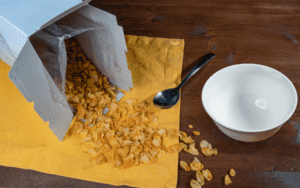 Poor quality food and nutrient deficiency can play a role in behavioral issues, attention or focus, sleep, even things like constipation! So you can see how having foods with low nutritional quality in your child’s diet can cause or exacerbate issues. This goes for gluten-free and dairy-free foods too.
Poor quality food and nutrient deficiency can play a role in behavioral issues, attention or focus, sleep, even things like constipation! So you can see how having foods with low nutritional quality in your child’s diet can cause or exacerbate issues. This goes for gluten-free and dairy-free foods too.
Processed foods are not typically nutrient dense and often have fillers, preservatives, and other chemicals. So when you transition to a gluten-free and dairy-free diet, try and stick to whole foods, or you could be either continuing the same problems or even creating new ones with these foods.
Success Strategy – Eat whole foods and cook from scratch! Once you determine what your child will/will not eat, batch cooking and doubling (or even tripling!) a recipe to eat later is a valuable tip. Muffins, meats, soups, and casseroles can all be stored in the freezer to be reheated for eating later. This allows you to maximize your time and still eat healthy, home made foods. If you do need to bring in some processed foods, review those ingredient labels and try and bolster your child’s diet with additional fresh vegetables and fruits in the way of smoothies or other creative ways to get them in. You can continue to slowly reduce the number of processed foods as you further hone your child’s diet.
10) Additional Food Compounds Irritating The Gut Or Body
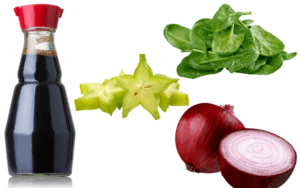 Inflammation can occur even on a gluten-free and dairy-free diet, depending on your child’s unique biochemistry. Things like oxalates, FODMAPs, histamine, and glutamate can be problematic for some individuals. Oxalates are inflammatory molecules that inhibit mineral absorption, cause dysbiosis, inflame the gut, and cause oxidative stress and pain. As mentioned above, FODMAPs are fermentable carbohydrates that bacteria feed on and can create gas, bloating, pain, diarrhea, and constipation. This is obviously no fun! Histamine is another culprit of inflammation. It is often thought of related to seasonal allergies and itchy, watery eyes, and sneezing. But foods that are high in or liberate histamine can cause other inflammatory issues on the inside of the body as well. And, if your child is also exposed to pollen or other environmental allergies, their “bucket” for histamine may overflow. Inflammation can worsen symptoms and impede the results of your GFCF diet.
Inflammation can occur even on a gluten-free and dairy-free diet, depending on your child’s unique biochemistry. Things like oxalates, FODMAPs, histamine, and glutamate can be problematic for some individuals. Oxalates are inflammatory molecules that inhibit mineral absorption, cause dysbiosis, inflame the gut, and cause oxidative stress and pain. As mentioned above, FODMAPs are fermentable carbohydrates that bacteria feed on and can create gas, bloating, pain, diarrhea, and constipation. This is obviously no fun! Histamine is another culprit of inflammation. It is often thought of related to seasonal allergies and itchy, watery eyes, and sneezing. But foods that are high in or liberate histamine can cause other inflammatory issues on the inside of the body as well. And, if your child is also exposed to pollen or other environmental allergies, their “bucket” for histamine may overflow. Inflammation can worsen symptoms and impede the results of your GFCF diet.
Success Strategy – While a gluten-free and dairy-free diet is a great foundation, removing additional foods or food compounds may also be necessary to get the results you are seeking for your child. Understanding your child’s specific dietary needs is important in determining the right personalized nutrition intervention for them. So rather than abandoning dietary intervention, it may be a case of fine-tuning. For example, A low oxalate diet can reduce harmful oxalate levels thereby reducing inflammation and pain. But, it can also be helpful with dysbiosis, as high oxalates damage the microbiome. Removing FODMAPs can reduce GI distress. Reducing high histamine foods during a high pollen time may reduce rashes or tummy aches.
To summarize, here are the 10 strategies to help when the GFCF diet is not working.
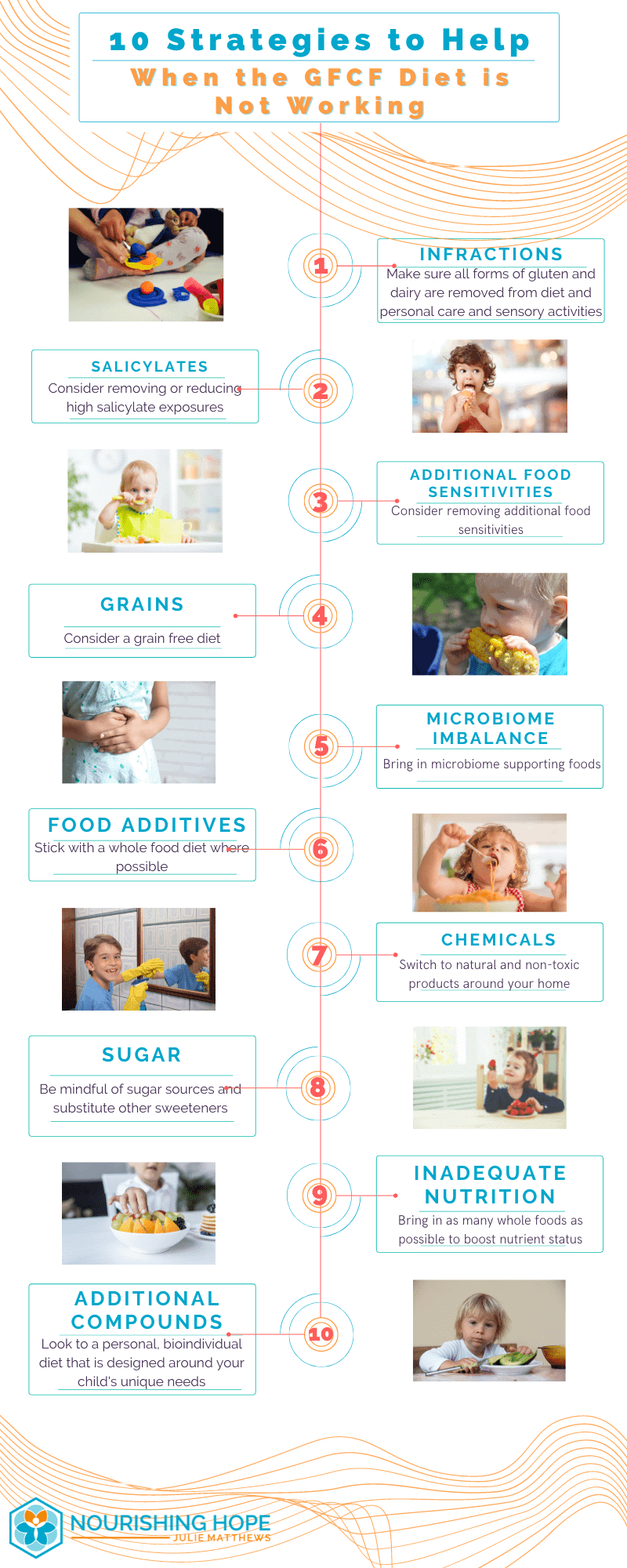
Personalized Nutrition for Success
The big takeaway point here is to not give up. A gluten-free and dairy-free diet is a great place to start for your child with autism. And many families see tremendous improvement from just that. But, if your child does not, there may be other factors at play or additional foods or food compounds that need to be removed as well.
And this is where taking your child’s unique needs into account is the key. What I’ve learned after working with thousands of families is that for a diet to be most successful, it needs to be tailored to the individual needs of each person. Personalized nutrition, or BioIndividual Nutrition™ as I call it, is about taking the specific diet principles your child needs and creating the personalized therapeutic diet plan that’s right for them.
If you would like step-by-step guidance, my Nourishing Hope for Healing Kids program walks you through implementing a healthy gluten-free and dairy-free diet but also teaches you how to figure out what additional special therapeutic diet(s) your child may benefit from and how to create a personalized nutrition plan that’s right for you. You’ll also have a community of families just like yours to connect with.




0 Comments